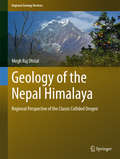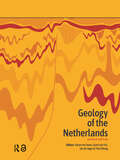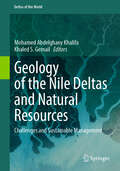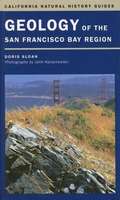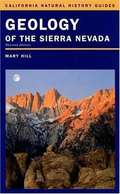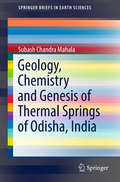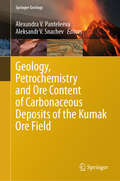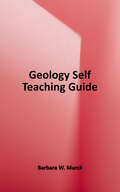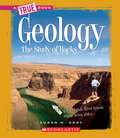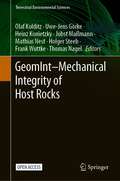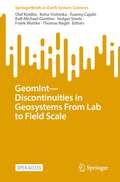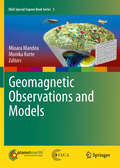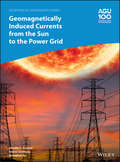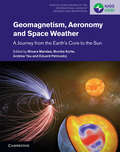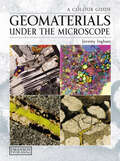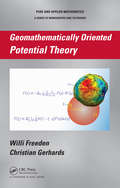- Table View
- List View
Geology of the Nepal Himalaya: Regional Perspective Of The Classic Collided Orogen (Regional Geology Reviews Ser.)
by Megh Raj DhitalThis book addresses the geology of the entire Himalayan range in Nepal, i. e. , from the Gangetic plain in the south to the Tethyan zone in the north. Without a comprehensive look at the various Himalayan zones, it is practically impossible to fully grasp the processes at work behind the formation and development of the spectacular Himalaya. However, the goal is not merely to document all the scientific ontology but rather to reveal a sound basis for the prevailing concepts. Both the early literature on Himalayan geology and contemporary trends are fully covered. For the first time, the origin, use, and abuse of common Himalayan geological terms such as the Siwaliks, Lesser Himalaya, Main Boundary Thrust, Main Central Thrust, and Tethys are discussed. The book will help readers to progress from a cognitive approach to a constructive one by linking various types of knowledge, such as seeking relations between various geological structures as well as between earlier thoughts or views and contemporary approaches.
Geology of the Netherlands: Second Edition
by Johan H. ten Veen Geert-Jan Vis Jan De Jager Theo E. WongBelow the famously flat surface of the Netherlands lies a fascinating world of buried mountains and valleys, which can only be unraveled with drillings, geophysical techniques and geological understanding.,Thorough exploration for hydrocarbons, groundwater and minerals produced a wealth of data and knowledge about the Dutch subsurface and its various uses. The second edition of this book, originally published in 2007, provides access to that wealth with a thoroughly revised and updated description of the Paleozoic to recent geology of the Netherlands, including the offshore. It covers applied geology with chapters on oil and gas, coal and peat, rock salt, groundwater, construction minerals, silica sand, underground storage and sequestration, and geothermal energy. It treats the natural and anthropogenic geohazards of seismicity and subsidence. Finally, it illustrates how data and knowledge of the Dutch subsurface are disseminated by the Geological Survey of the Netherlands, part of research and technology organisation TNO.,Geology of the Netherlands is a comprehensive reference work for geologists, engineers, geoscience students, and all others who wish to know more about the relevance and applications of geology in the Netherlands.
Geology of the Nile Deltas and Natural Resources: Challenges and Sustainable Management (Deltas of the World)
by Mohamed Abdelghany Khalifa Khaled S. GemailThis book is essential for understanding the Nile Delta, recognized as one of the world's most vulnerable deltas due to population growth and the impacts of sea level rise (SLR). Spanning approximately 38,000 square kilometers, the Nile Delta is the largest delta globally, warranting an in-depth exploration of its geology, hydrocarbon potential, and water resources. This comprehensive volume provides detailed geological insights into both the Recent Nile Delta and the ancient deposits of the El-Fayoum Nile Delta. It highlights the subsurface lithostratigraphic rock units, elucidating possible depositional environments and the distribution and extent of water and hydrocarbon reservoirs. Additionally, the book examines the structural elements that influenced sedimentary rock deposition, supported by well logs and seismic data. For the first time, the book presents critical geological information on both onshore and offshore gas reservoirs, assessing the Nile Delta's hydrocarbon production capacity, organic petrography, and the geochemical characterization of its resources. Employing a multidisciplinary approach that integrates geological, hydrogeological, numerical, and machine learning modeling with geophysical data, this book assesses and monitors the quality and quantity of natural resources for sustainable management in the Nile Delta, Egypt. This book crucially addresses the natural resource challenges posed by climatic changes and anthropogenic stressors, while recommending sustainable practices for development. It aligns with several Sustainable Development Goals (SDGs), including SDG 6: Clean Water and Sanitation, SDG 7: Affordable and Clean Energy, SDG 11: Sustainable Cities and Communities, SDG 13: Climate Action, and SDG 15: Life on Land.<span class="EOP SCXW14652096 BCX0" data-ccp-props="{&quo
Geology of the Oman Mountains, Eastern Arabia (GeoGuide)
by Mike SearleThis book describes in detail numerous geological sites throughout the mountains of Oman and the United Arab Emirates (UAE) in Eastern Arabia. The region is well known for its oil and gas reserves in the desert interior, and Permian-Mesozoic shelf carbonates exposed in the mountains of the Musandam peninsula, Jebel al-Akhdar and Saih Hatat, where deep wadi canyons provide impressive three-dimensional views into the crust. The region has numerous globally important geological sites, including the world’s largest and best-exposed ophiolite complex, the Semail Ophiolite, which is a vast thrust sheet of Cretaceous ocean crust and upper mantle emplaced onto the Arabian continental margin. Other sites include spectacular fossil localities, subduction zone metamorphic rocks (eclogites, blueschists, amphibolites), fold-thrust belts, giant sheath folds and Precambrian salt domes, as well as the huge sand dunes of the Rub al’Khali, the Empty Quarter, and the separate Wahiba (Sharkiyah) sandsea of Eastern Oman.Written by Mike Searle, who has worked on geological research projects throughout Oman and UAE almost every year since 1978, this book describes the field geology of each site and includes a wealth of maps, field photos and diagrams illustrating key features. It also discusses the history of exploration of Arabia and the search for its hidden geological secrets. The book provides the geological basis for the establishment of a series of World Heritage Sites, National GeoParks and Sites of Special Scientific Interest (SSSI) throughout the region. As such, it is of interest to geologists, tourists, mountaineers, trekkers, rock climbers and naturalists.
Geology of the San Francisco Bay Region (California Natural History Guides)
by Doris SloanThis book is for San Francisco Bay Area residents and visitors who want to explore the geologic world of this spectacular area, to learn about its shapes, colors, and rocky foundations. Doris Sloan illuminates the colorful geologic mosaic that surrounds San Francisco Bay and lucidly explains the complex and fascinating processes that have forged it over millions of years.
Geology of the Sierra Nevada (Revised Edition)
by Mary HillThe author introduces the rocks of the Sierra Nevada, which tell the mountains' tale, and explains how nature's forces, such as volcanic eruptions, earthquakes, faulting, erosion, and glaciation formed the range's world-renowned scenery and mineral wealth, including gold.
Geology, Chemistry and Genesis of Thermal Springs of Odisha, India (Springerbriefs In Earth Sciences Ser.)
by Subash Chandra MahalaThis book presents a comprehensive overview of the nature of manifestation and general aspects of thermal springs of Odisha. A detailed description of geological formations and the relationship between tectonic settings with thermal spring emanation is given for better understanding of the geothermal system. Physico-chemical characteristics of water and gas have been studied and interpreted to ascertain the nature and source of geothermal fluid and to generate a conceptual model on the origin. The book can serve as a valuable reference for earth scientists, planners and researchers in the field of geothermal energy. As the thermal springs are spectacular sites for tourists this illustrated book can also help tourists, tourist guides and tourism departments.
Geology, Geochemistry and Formation of Supergene Mineral Deposits in Deeply Weathered Terrain (Mineral Resource Reviews)
by Rob J. Bowell Charles R. M. ButtThis book provides a comprehensive overview of the major supergene mineral deposits formed in intensely weathered lateritic terrains. It discusses both contemporary and pre-existing supergene deposits, describing their geological, mineralogical and geochemical characteristics. Supergene processes of enrichment are those that occur under ambient near-surface conditions, compared to hypogene processes mostly at depth under higher temperatures and pressures. Supergene processes include the predominance of meteoric water circulation with concomitant oxidation and chemical weathering. Descending meteoric waters oxidize the primary (hypogene) minerals and redistribute the chemical elements. Residual supergene enrichment occurs as a physical process when the predominant rock-forming minerals oxidize and dissolve, concentrating ore elements hosted in resistant stable minerals; absolute chemical enrichment occurs when the ore elements themselves are leached and migrate in groundwater and precipitate due changes in the pH, oxidation potential and chemical composition of water. These processes can enrich commercially important elements to produce orebodies formed entirely by supergene processes. These include Al (bauxite), Fe ore, Ni-Co laterites, kaolinite, REE (clay deposits), Nb and REE (on carbonatites), base metals (secondary <span class="
Geology, Petrochemistry and Ore Content of Carbonaceous Deposits of the Kumak Ore Field (Springer Geology)
by Alexandra V. Panteleeva Aleksandr V. SnachevThe main prospects for expanding the mineral resource base of gold are associated with the discovery of typical ore objects within the distribution of productive black shale strata in the Orenburg part of the Southern Urals. The solution of this problem is significantly associated with the discovery, evaluation and involvement in the industrial development of gold deposits lying in the black shale strata. Their practical significance, based on existing concepts, can be considered in several aspects: first of all, it is a possible source of metals, and secondly, they are a reducing geochemical barrier for the deposition of ore matter of deep fluids. The formations of the black shale formation are a favorable geochemical environment for the primary concentration of gold, platinum group elements, tungsten, molybdenum and other metals. Areas of manifestation of tectonic activity, zonal and contact metamorphism, and the dyke complex are of great importance. Moreover, carbonaceous deposits are a very informative material for the reconstruction of paleogeographic and physico-chemical conditions of their accumulation. In this regard, the ore-containing black shales of the Kumak deposit, whose rocks have a specialization in gold, seem to be a very attractive object for a comprehensive study of ore content. They may be of great practical importance for the search for new deposits in the Southern Urals and in other regions with a similar geological structure.
Geology, Petrography and Geochemistry of Basaltic Rock in Central India
by Chaitanya B. PandeThis book examines novel geological formations and lava flows of basaltic rock in India, and provides a comprehensive understanding of basaltic rock geology, petrography, stratigraphy and geochemistry. Readers are given insight into the geologic conditions of basaltic rock in central India, and a basic introduction to field geology methods and parameters in the study region. The author shows detailed petrographic and mineralogical characteristics of various basaltic rock formations, and identifies key features using major, trace and rare earth element stratigraphic analysis. An analysis of the sequence of hydro-geological formations of the basaltic rock area using ground water fluctuation models is also provided to assess surface and groundwater resources, which are important for planning development in the basaltic hard rock area. The book aims to be a resource for researchers, scientists, teachers and students interested in geology, petrography and geochemistry.
Geology: A Complete Introduction: Teach Yourself
by David RotheryWhat processes and physical materials have shaped the planet we live on? Why do earthquakes happen? And what can geology teach us about contemporary issues such as climate change?From volcanoes and glaciers to fossils and rock formations, this user-friendly book gives a structured and thorough overview of the geology of planet Earth and beyond. Geology: A Complete Introduction outlines the basics in clear English, and provides added-value features like a glossary of the essential jargon terms, links to useful websites, and examples of questions you might be asked in a seminar or exam.Topics covered include the Earth's structure, earthquakes, plate tectonics, volcanoes, igneous intrusions, metamorphism, weathering, erosion, deposition, deformation, physical resources, past life and fossils, the history of the Earth, Solar System geology, and geological fieldwork. There are useful appendices on minerals, rock names and geological time.Whether you are preparing for an essay, studying for an exam or simply want to enrich your hobby or expand your knowledge, Geology: A Complete Introduction is your essential guide.David Rothery is a volcanologist, geologist, planetary scientist and Professor of Planetary Geosciences at the Open University. He has done fieldwork in the UK, USA, Australia, Oman, Chile and Central America, and visited many other parts of the world.
Geology: A Self-teaching Guide
by Barbara MurckTake a learning journey through billions of years of Earthhistory This indispensable guide to the fundamentals of geology is theideal way to introduce yourself to all the basics, from rocks,minerals, and fossil fuels to earthquakes, volcanoes, and platetectonics. Using quick quizzes and self-tests to reinforce keyconcepts, Geology carefully walks you through billions of years ofEarth history. Illustrated with more than one hundred speciallycommissioned illustrations and fifty photographs that help clarifydifficult concepts, this easy-to-follow book is an interactiveresource for anyone interested in learning more about ourplanet. Whether you are new to geology or want to refresh and update yourknowledge, the proven self-teaching guide approach will allow youto work at your own pace, check your progress, and learn more aboutthis fascinating field of study.
Geology: Basics for Engineers
by Aurele ParriauxGeology – Basics for Engineers presents the physical and chemical characteristics of the Earth, the nature and the properties of rocks and unconsolidated deposits/sediments, the action of water, how the earth is transformed by various phenomena at different scales of time and space. The book shows the engineer how to take geological conditions into account in his projects, and how to exploit a wide range of natural resources in an intelligent way, reduce geological hazards, and manage subsurface pollution.Through a problem-based-learning approach, this instructional text imparts knowledge and practical experience to engineering students (undergraduate and graduate level), as well as to experts in the fields of civil engineering, environmental engineering, earth sciences, architecture, land and urban planning. The DVD that supplements the book contains solutions to the problems and animations that show additional facets of the living Earth. *The original French edition of the book (2007) won the prestigious Roberval Prize, an international contest organized by the University of Technology of Compiegne in collaboration with the General Council of Oise, France. Geology, Basics for Engineers, was selected out of a total of 110 candidates.The jury praised the book as a “very well conceived teaching textbook” and underscored its highly didactic nature, as well as the excellent quality of its illustrations.
Geology: Basics for Engineers, Second Edition
by Aurèle ParriauxGeology – Basics for Engineers (second edition) presents the physical and chemical characteristics of the Earth, the nature and the properties of rocks and unconsolidated deposits/sediments, the action of water, how the Earth is transformed by various phenomena at different scales of time and space. The book shows the engineer how to take geological conditions into account in their projects, and how to exploit a wide range of natural resources in an intelligent way, reduce geological hazards, and manage subsurface pollution. This second edition has been fully revised and updated. Through a problem-based learning approach, this instructional text imparts knowledge and practical experience to engineering students (undergraduate and graduate level), as well as to experts in the fields of civil engineering, environmental engineering, earth sciences, architecture, land and urban planning. Free digital supplements to the book, found on the book page, contain solutions to the problems and animations that show additional facets of the living Earth. The original French edition of the book (2007) won the prestigious Roberval Prize, an international contest organized by the University of Technology of Compiegne in collaboration with the General Council of Oise, France. Geology, Basics for Engineers was selected out of a total of 110 candidates. The jury praised the book as a "very well conceived teaching textbook" and underscored its highly didactic nature, as well as the excellent quality of its illustrations.
Geology: Teach Yourself
by David RotheryWritten by David Rothery, who is Professor of Planetary Geosciences at the Open University, Geology: A Complete Introduction is designed to give you everything you need to succeed, all in one place. It covers the key areas that students are expected to be confident in, outlining the basics in clear English, and then providing added-value features like a glossary of the essential jargon terms, links to useful websites, and even examples of questions you might be asked in a seminar or exam. The book uses a structure chosen to cover the essentials of most school and university courses on Geology. Topics covered include the Earth's structure, earthquakes, plate tectonics, volcanoes, igneous intrusions, metamorphism, weathering, erosion, deposition, deformation, physical resources, past life and fossils, the history of the Earth, Solar System geology, and geological fieldwork. There are useful appendices of minerals, rock names and geological time.
Geology: The Study Of Rocks
by Susan Heinrichs GrayWhether you're interested in weather, oceans, or even the prehistoric world, earth science covers it all. The fascinating facts and fun activities in these titles help the budding earth scientist in you explore the fields of geology, meteorology, ecology, and more.
GeomInt–Mechanical Integrity of Host Rocks (Terrestrial Environmental Sciences)
by Thomas Nagel Uwe-Jens Görke Olaf Kolditz Frank Wuttke Heinz Konietzky Jobst Maßmann Mathias Nest Holger SteebThis open access book summarizes the results of the collaborative project “GeomInt: Geomechanical integrity of host and barrier rocks - experiment, modeling and analysis of discontinuities” within the Program: Geo Research for Sustainability (GEO: N) of the Federal Ministry of Education and Research (BMBF). The use of geosystems as a source of resources, a storage space, for installing underground municipal or traffic infrastructure has become much more intensive and diverse in recent years. Increasing utilization of the geological environment requires careful analyses of the rock–fluid systems as well as assessments of the feasibility, efficiency and environmental impacts of the technologies under consideration. The establishment of safe, economic and ecological operation of underground geosystems requires a comprehensive understanding of the physical, (geo)chemical and microbiological processes on all relevant time and length scales. This understanding can only be deepened on the basis of intensive laboratory and in-situ experiments in conjunction with reliable studies on the modeling and simulation (numerical experiments) of the corresponding multi-physical/chemical processes. The present work provides a unique handbook for experimentalists, modelers, analysts and even decision makers concerning the characterization of various types of host rocks (salt, clay, crystalline formations) for various geotechnical applications.
GeomInt—Discontinuities in Geosystems From Lab to Field Scale (SpringerBriefs in Earth System Sciences)
by Thomas Nagel Olaf Kolditz Frank Wuttke Holger Steeb Keita Yoshioka Tuanny Cajuhi Ralf-Michael GüntherThis is an open access book. In view of growing conflicts over strategic georesources, the use of the geological subsurface in the sense of a regional resource is becoming increasingly important. In this context, georeservoirs are playing an important role for the energy transition not only as a source of energy but also as a storage facility and deep geological disposal for energy waste. The success of the energy transition also depends to a large extent on the efficient and safe use of underground resources.This book complements the previous basic book (GeomInt—Integrity of Host Rocks) with a series of application examples in different rock formations, clay, salt, and crystalline. The methodology developed in GeomInt is used, among others, in the Mont Terri underground research laboratory (Opalinus Clay), in the large borehole test in Springen (salt rock) and in the “Reiche Zeche” teaching and research mine (crystalline rock). In addition, new methodological developments are also taken up in experiments and models and embedded in workflows for geotechnical system analyses. The present book summarizes the results of the collaborative project “GeomInt2: Geomechanical integrity of host and barrier rocks - experiment, modeling and analysis of discontinuities” within the program: Geo Research for Sustainability (GEO: N) of the Federal Ministry of Education and Research (BMBF).
Geomagnetic Observations and Models
by M. Mandea Monika KorteThis volume provides comprehensive and authoritative coverage of all the main areas linked to geomagnetic field observation, from instrumentation to methodology, on ground or near-Earth. Efforts are also focused on a 21st century e-Science approach to open access to all geomagnetic data, but also to the data preservation, data discovery, data rescue, and capacity building. Finally, modeling magnetic fields with different internal origins, with their variation in space and time, is an attempt to draw together into one place the traditional work in producing models as IGRF or describing the magnetic anomalies.
Geomagnetically Induced Currents from the Sun to the Power Grid (Geophysical Monograph Series #246)
by Jennifer L. Gannon Andrei Swidinsky Zhonghua XuAn introduction to geomagnetic storms and the hazards they pose at the Earth’s surface Geomagnetic storms are a type of space weather event that can create Geomagnetically Induced Currents (GICs) which, once they reach Earth’s surface, can interfere with power grids and transport infrastructure. Understanding the characteristics and impacts of GICs requires scientific insights from solar physics, magnetospheric physics, aeronomy, and ionospheric physics, as well as geophysics and power engineering. Geomagnetically Induced Currents from the Sun to the Power Grid is a practical introduction for researchers and practitioners that provides tools and techniques from across these disciplines. Volume highlights include: Analysis of causes of geomagnetic storms that create GICs Data and methods used to analyze and forecast GIC hazard GIC impacts on the infrastructure of the bulk power system Analysis techniques used in different areas of GIC research New methods to validate and predict GICs in transmission systems
Geomagnetism, Aeronomy and Space Weather: A Journey from the Earth's Core to the Sun (Special Publications of the International Union of Geodesy and Geophysics #4)
by Monika Korte Eduard Petrovský Mioara Mandea Andrew YauOn the centenary of the International Union of Geodesy and Geophysics, this book reviews the state-of-the-art research in geomagnetism, aeronomy and space weather. Written by eminent researchers from these fields, it summarises the advances in research over the past 100 years, and looks ahead to current and emerging studies on Earth's magnetic field. It provides a comprehensive overview of the generation of Earth's magnetic field, its history and its response to external forces. Starting at the centre of the Earth, the reader is taken on a journey from the interior core and mantle, through the upper atmosphere and magnetosphere, before reaching the Sun's atmosphere and corona. The applications of this research are also discussed, particularly the societal impact of solar activity on critical infrastructures in our increasingly technologically dependant society. This book provides a valuable resource and reference to academic researchers and students in geomagnetism and aeronomy.
Geomaterials Under the Microscope: A Colour Guide
by Jeremy InghamThe first comprehensive guide to the petrography of geomaterials, making the petrographers specialist knowledge available to practitioners, educators and students worldwide interested in modern and historic construction materials.
Geomathematically Oriented Potential Theory (Chapman & Hall/CRC Pure and Applied Mathematics)
by Willi Freeden Christian GerhardsAs the Earth`s surface deviates from its spherical shape by less than 0.4 percent of its radius and today's satellite missions collect their gravitational and magnetic data on nearly spherical orbits, sphere-oriented mathematical methods and tools play important roles in studying the Earth's gravitational and magnetic field. Geomathematically Orien
Geomathematics: Modelling and Solving Mathematical Problems in Geodesy and Geophysics
by Volker MichelGeomathematics provides a comprehensive summary of the mathematical principles behind key topics in geophysics and geodesy, covering the foundations of gravimetry, geomagnetics and seismology. Theorems and their proofs explain why physical realities in geoscience are the logical mathematical consequences of basic laws. The book also derives and analyzes the theory and numerical aspects of established systems of basis functions; and presents an algorithm for combining different types of trial functions. Topics cover inverse problems and their regularization, the Laplace/Poisson equation, boundary-value problems, foundations of potential theory, the Poisson integral formula, spherical harmonics, Legendre polynomials and functions, radial basis functions, the Biot-Savart law, decomposition theorems (orthogonal, Helmholtz, and Mie), basics of continuum mechanics, conservation laws, modelling of seismic waves, the Cauchy-Navier equation, seismic rays, and travel-time tomography. Each chapter ends with review questions, with solutions for instructors available online, providing a valuable reference for graduate students and researchers.
